Category: CONSERVATION AGRICULTURE
 |
This article is the 26th and final of a series of articles highlighting crop species that can play an imperative role in conservation agriculture (CA)-based crop-pasture rotations. Besides improving the physical, chemical, hydrological and biological properties of the soil, such species, including annual or perennial cover crops, can successfully be used as animal feed.
Livestock production systems are in many ways dependent on the utilisation of forage species, or pasture ley and cover crops (used interchangeably in this article), and can therefore become an integral component of CA-based crop-pasture rotations.
To qualify as a pasture ley crop, a plant species must fulfil the requirements of a dual purpose crop, i.e. it must be functional for livestock fodder and for soil restoration. This article concludes the series and focuses on the way these different species can be incorporated into cropping systems as ‘pasture ley’ crops.
The term ‘pasture ley’ can include a variety of annual or perennial species, legumes, grasses or root forage crops used in short or long-term rotations. It is therefore important to distinguish between a short term and long term ley cropping system.
With the declining fertility and productive capacity of many South African cropping soils, there is an increasing need to develop successful ley pasture systems in grain producing regions. Ley pastures in crop rotations have the ability to reverse declining soil health and various properties, improve livestock productivity and reduce rising environmental problems.
The past series of articles on different species have highlighted the important benefits of such species as an integral part of crop livestock CA systems. These benefits include: Improved nutrient cycling and soil biodiversity, reduced erosion, compaction and nutrient leaching, improved soil aeration and water conservation, increased carbon sequestration and storage.
It is however important to understand the attributes of the different ley pasture species, as the wrong combination of species can lead to negative effects on succeeding crops. Legume pasture ley crops are most commonly used for nitrogen contribution because of their ability to fixate nitrogen to be used by a following crop. Grass ley crops are more widely used to control soil erosion, to control weeds, improve nutrient recycling and carbon sequestration and to improve soil structure as a result of soil compaction.
Brassicas are used to reduce compaction and increase soil structure through increased levels of organic matter, recycle nutrients and to suppress diseases and weeds.
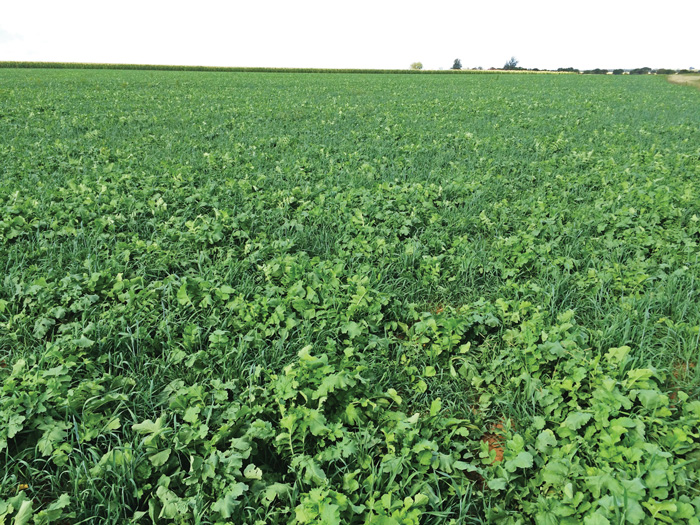 |
A winter cover crop mixture, Ottosdal, North West Province. Photo: Hendrik Smith |
The following section provides information about different ley or cover crops grown during, in-between or after cash crops. Emphasis is given to the summer rainfall area of South Africa. These crops should preferably be planted as multi-species mixture and utilised through mob grazing, or short-duration, high-intensity grazing. The ideal is to have a diversity of living roots in the soil for the entire year to boost soil health.
After maize or soybeans, or late in growing season (as a winter cover crop or relay crop)
Cereal rye, annual ryegrass, wheat, oats or triticale as grasses can be planted to accumulate soil organic matter, recycle nutrients, and reduce soil compaction (see Photo 1).
Brassicas (oilseed or tillage radish or turnips) is used to recycle nutrients, reduce compaction, and promote weed and disease suppression. Vetch can be planted as a nitrogen source. Relay cropping is the technique of seeding these winter cover crops into a maize crop. The cover crops germinate and grow slowly under the maize canopy (see Photo 2a and Photo 2b).
When the maize is harvested in the fall or winter, the cover crops are already established and growth resumes, saving valuable time. Generally, the relay crop will have far more growth throughout the winter and spring, than will any cover crop seeded after maize harvest.
Apart from the advantage for livestock integration, there are many other economic and environmental benefits.
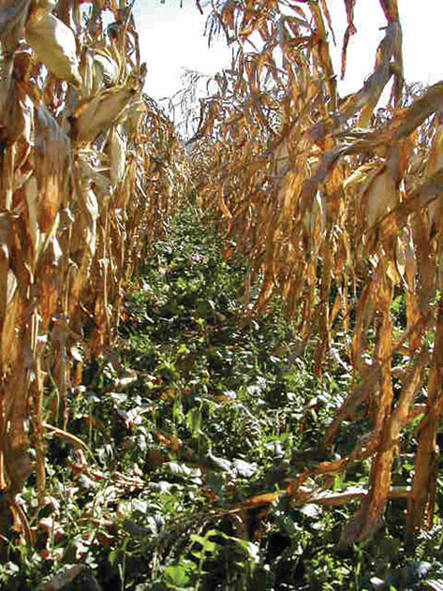 |
A relay cropping system with maize and a winter cover crop mixture of oats, radish and vetch. Photos: Hendrik Smith and Gerrie Trytsman |
During growing season, in-between cash crops (as summer pasture ley fallow)
Crops such as babala, forage sorghum, cowpea, soybeans, mung beans, dolichos lablab, velvet bean, sun hemp and jack bean can be used. These multi-specie systems should preferably be grazed twice in the growing season, once in early summer to maximise root growth (five times more root growth after first grazing) and once in late summer to increase organic matter decomposition (see Photo 3). If required, crop growth could be terminated with herbicides or with a knife roller. Time of termination depends on the need to store or conserve soil water for the next crop.
During growing season, simultaneously with maize (as intercrop)
Non-climbers (such as cowpea, mucuna or velvet bean) or climbers (dolichos lablab and velvet bean) can be sown two to eight weeks after planting maize. Later plantings have less impact on maize yield, however. The earlier the ley crops are sown, the greater the soil protection and weed suppression obtained.
In smallholder systems, intercrops are also planted as food source, such as dry beans or cowpeas, which residues could also be used for animal feed (see Photo 4).
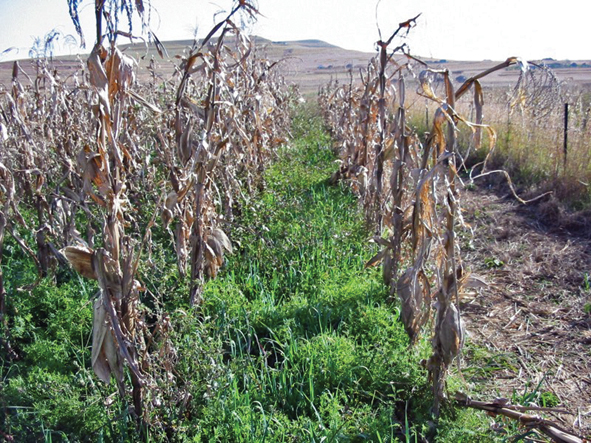 |
A relay cropping system with maize and a winter cover crop mixture of oats, radish and vetch. Photos: Hendrik Smith and Gerrie Trytsman |
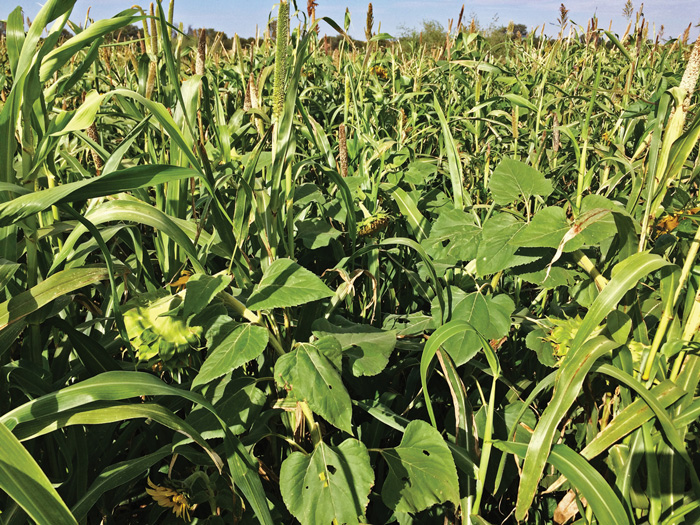 |
A summer cover crop mixture, Ottosdal, North West Province. Photo: Hendrik Smith |
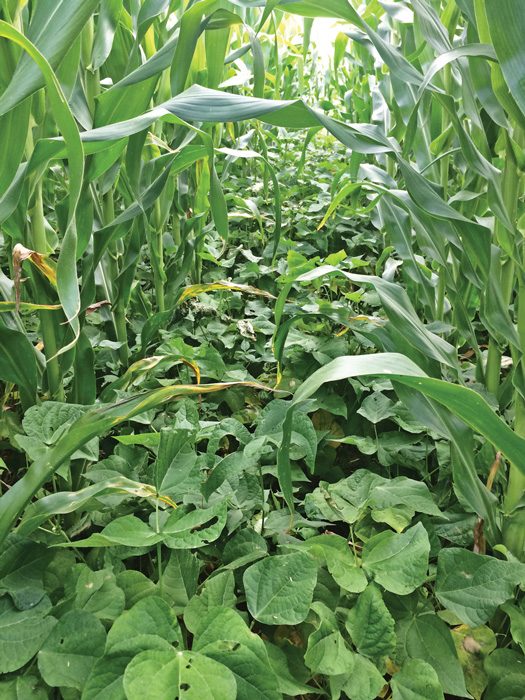 |
Maize intercropped with cowpeas, Bergville, KwaZulu-Natal. Photo: Hendrik Smith |
A suite of cover crops are available for producers to plant for a specific purpose and can include the following (species listed are not limited and other options do exist):
Quick forage which can be grazed
Oats, forage radishes, turnips, triticale and stooling rye, and annual ryegrass, teff for dry lands, babala, forage sorghum and barley.
Start up or enhance no-till
Forage radish, turnips, babala and forage sorghum. Babala and forage sorghum can result in very high residue amounts for soil cover.
Prevention of soil erosion
Grasses have fibrous root systems to bind soil, and the best grass cover crops include babala, forage sorghum, cereal rye, annual ryegrass, oats, wheat and barley. Other cover crops include lablab, buckwheat (with a shallow fibrous root system), cowpea and winter pea.
Pasture ley crops for soil carbon build-up (to increase C:N ratio)
Summer annuals: Babala and forage sorghum.
Winter annuals: Cereal rye, annual ryegrass, triticale, oats, wheat and barley.
Perennials: Sub-tropical grasses, for example Rhodes grass, Smuts finger grass, weeping love grass, Guinea grass, blue buffalo grass and tall fescue (see Photo 5)
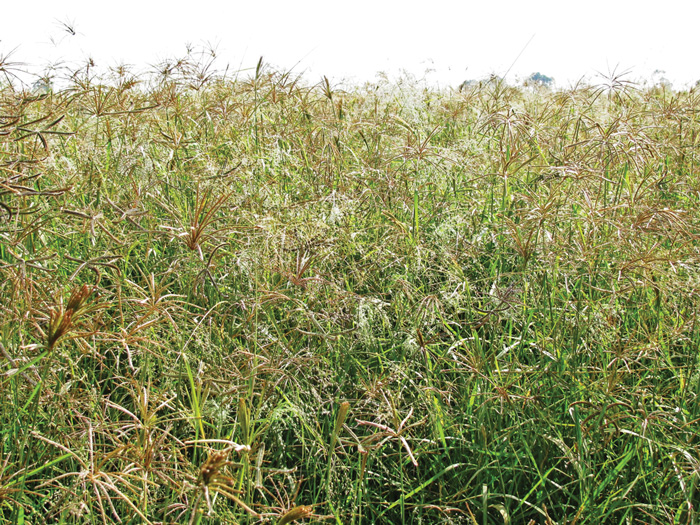 |
Rhodes grass mixed with white Buffalo grass at Ventersdorp. Photo: Gerrie Trytsman |
Pasture ley crops for soil nitrogen increase (to decrease C:N ratio)
Summer annuals: Cowpea, soybeans, mung beans, dolichos lablab, velvet bean, jack bean and sun hemp.
Winter annuals: Winter pea, red clover, sweet clover, vetch, serradella and lupines.
Perennials: Lucerne, poor man’s lucerne and fine stem stylo.
Requires no herbicide to kill
Oats, cowpea, winter pea, forage radish and turnips.
Reduction in compaction (deep rooted)
Babala, forage sorghum, annual ryegrass, forage radish, sweet clover, cereal rye, oats and dolichos lablab.
Recycle excess nutrients (nitrogen, phosphorus)
Forage and tillage radish, turnips, annual ryegrass, cereal rye, oats, wheat, babala, forage sorghum, sweet clover, winter pea, cowpea, red clover and vetch species.
In general, legumes need P for N fixation but are unfortunately poor users of P in the soil. Since legumes can contribute to soil acidification, it can result in P becoming more available when P is fixed and limiting.
In general, grass cover crops store and supply more P than legumes because they have a finer root system and more surface area than legumes with a taproot. In mixed legume-grass pastures, the legume cycles N to the grass and the grass cycles P to the legume.
Natural herbicides or allelopathic effects for weed suppression
Cereal rye, forage radish, oats, barley, babala and forage sorghum. Annual ryegrass, cereal rye, and sorghum may be used for controlling soybean cyst nematodes.
Attract beneficial insects
Buckwheat, sweet clover, red clover and other selected clover and vetch species, sun hemp, sunflower, dolichos lablab and sorghum.
Tolerate wet soils
White clover, red clover, other selected clover species, annual ryegrass, cereal rye, wheat and oats.
Tolerate heat and drought
Dolichos lablab, cowpea, vetch species, mung beans, sweet clover, sorghum, babala, barley and teff.
Cold tolerant
Stooling rye, oats, wheat, triticale, winter pea and selected clover species.
Nurse crop
Summer annuals: Teff. Winter annuals: Oats and annual ryegrass.
Table 1 shows an overview of the major pasture ley species that serve as forage for animals (cattle, pigs, sheep, chickens and fish).
|
CA cropping system type |
Growing period |
Advantages |
Disadvantages |
Suitable species commonly used |
Dry matter (DM) and meat production (g/d) |
|---|---|---|---|---|---|
|
Non-legume forage crops |
< 1 year |
Easy establishment. |
No nitrogen fixed. |
Temperate annuals: |
3 - 6 ton DM/ha 4 - 6 ton DM/ha 8 - 10 ton DM/ha |
|
Annual legumes |
< 1 year |
Boost soil nitrogen available for subsequent crops. |
Provide limited ground cover. |
Summer:
|
3 - 5 ton DM/ha
|
|
Perennial legume |
1 - 4 year |
Boost soil nitrogen available for subsequent crops. |
Limited improvement in SOM. |
Lucerne Poor man’s lucerne Butterfly pea |
6 - 8 ton DM/ha Not very productive in trials ADG: 850 - 900 g/d |
|
Tropical grasses |
1 - 4 year |
Reduce weed populations. |
Lower cropping intensity |
Grasses (summer): |
8 ton 10 ton DM/ha |
|
Tropical grasses/ legume mixtures |
>4 year |
Better utilisation of resources. Nutritionally balanced forage. |
Less N fixed and available as in pure legumes. |
Legumes: |
10 - 12 ton DM/ha |
Pasture ley and cover crops offer many benefits to producers that increase farm profitability and environmental sustainability. Each pasture ley and cover crop has a niche or special purpose. Legume pasture ley and cover crops are typically used to improve soil nitrogen levels. Grass pasture ley and cover crops are used to increase soil organic matter, recycle excess nutrients and reduce soil compaction.
Brassica crops are grown to loosen the soil, recycle nutrients and suppress weeds. Some other cover crops are grown to suppress insects, disease, weeds or attract beneficial insects. Therefore, cover crops should be considered an integral part of any farming system aiming to efficiently utilise nutrients, improve soil health and increase farm profitability.
For more information, contact Dr Wayne Truter at wayne.truter@up.ac.za, Prof Chris Dannhauser at admin@GrassSA.co.za, Dr Hendrik Smith at hendrik.smith@grainsa.co.za or Mr Gerrie Trytsman at gtrytsman@arc.agric.za.
Hoorman, JJ, Islam, R and Sundermeier, A. 2009. Sustainable crop rotations with cover crops. Fact Sheet SAG-9-09, Agriculture and Natural Resources: Ohio State University, Extension.
Smith, HJ and Trytsman, G. 2011. The integration of livestock with conservation agriculture. Veeplaas.
Truter, WF, Dannhauser, CS, Smith, H and Trytsman, G. 2014. Integrated crop and pasture-based livestock production system. SA Graan/Grain.
Willey, RW. 1985. Evaluation and presentation of intercropping advantages. Experimental Agriculture 2, 119 - 133.